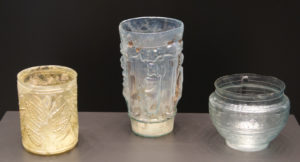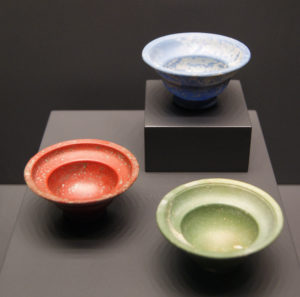We nearly decided not to go, but I’m so glad we did go. With two Gettys on offer, the Museum and the Villa, the Museum seemed like the best bet. And although it was marvellous to see the Rembrandts and the French decorative arts and furniture, we weren’t quite prepared for quite how wonderful the Villa and its display were. Perched atop bluffs on Malibu beach this is, of course, the more famous of the two buildings.
 Although I’ve never been particularly interested in Antiquities professionally, as I find the area too much of a minefield provenance-wise, I have always loved Roman and ancient glass. As luck would have it, an upstairs room contained a temporary exhibition called Molten Color about early glassmaking techniques. Showcasing the collection of early collector Erwin Oppenlander, the fascinating displays covered the major techniques of coil-forming, mould blowing, freehand blowing, mosaic, casting, and cutting and engraving. When glassmakers say there’s nothing new in glass, they mean it – these techniques are still mainstays today, but were developed and practised thousands of years ago by the Mesopotamians in c2,500 B.C., and then taken up by the Phoenecians and the Romans.
Although I’ve never been particularly interested in Antiquities professionally, as I find the area too much of a minefield provenance-wise, I have always loved Roman and ancient glass. As luck would have it, an upstairs room contained a temporary exhibition called Molten Color about early glassmaking techniques. Showcasing the collection of early collector Erwin Oppenlander, the fascinating displays covered the major techniques of coil-forming, mould blowing, freehand blowing, mosaic, casting, and cutting and engraving. When glassmakers say there’s nothing new in glass, they mean it – these techniques are still mainstays today, but were developed and practised thousands of years ago by the Mesopotamians in c2,500 B.C., and then taken up by the Phoenecians and the Romans.
What surprised me the most was how ‘modern’ (and thus timeless) some of these ancient pieces appear – particularly the mosaic and cast designs in vibrant colours. The image below on the right is typical, with the bowls also having an Oriental feel to them. Even some of the Roman freeblown designs were early echoes of 20thC designs produced in Czechoslovakia and Murano. If their designers weren’t entirely inspired by them, we do know that the famed Louis Comfort Tiffany was. The iridescent, encrusted surfaces that this glass took on after being buried for centuries inspired him to create his most ‘Favrile’ and ‘Lava’ glass.
 Glass doesn’t fade over time, or in the light like dyed textiles, so the exhibition really did look jewel-like. The incredible condition and comparatively large sizes of some pieces were quite breath-taking when considering their age. It’s almost enough to start me collecting but, even though much Roman domestic glass can be picked up for anything from £50-500, I’m sure I couldn’t even afford to buy one of these incredible pieces.
Glass doesn’t fade over time, or in the light like dyed textiles, so the exhibition really did look jewel-like. The incredible condition and comparatively large sizes of some pieces were quite breath-taking when considering their age. It’s almost enough to start me collecting but, even though much Roman domestic glass can be picked up for anything from £50-500, I’m sure I couldn’t even afford to buy one of these incredible pieces.
And all this before you see the rest of the amazing ancient exhibits! From statuary, to urns, architectural features, busts, and the largest collection of ancient Egyptian painted sarcophagus portraits, the scope and high quality is truly sensational. Arranged helpfully by theme, and highlighted with masterpieces such as the bronze ‘Victorious Youth’, the Cycladic harp player, and John Paul Getty’s favourite statue of Hercules, our notional ‘few hours’ in the morning turned into a full day. And it’s free to get in, but you must book tickets in advance. The setting is stunning, the ancient Roman-style building delightfully and entirely forgiveable by even the most hardcore scholar, and the gardens and restaurant provide great places to recharge before continuing your exploration. In short: amazing!

